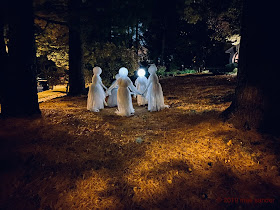 |
From the 1970s: Devil's Food Twinkies.
Still sometimes sold in "selected markets." |
Devil's Food Cake. Deviled Ham. Deviled Eggs. Deviled Crab. A menu for Halloween? Sounds good to me! Never mind all those pumpkin and pumpkin spice dishes! Give me chocolate, mustard, and hot pepper! I wrote these words in 2014, when posting about Halloween, and I've decided to re-post this because it's still quite interesting.
I wondered if devil-themed foods might have anything to do with Devil's Night. Looking into it, I learned that most of my information about Halloween customs and Devil's Night was inaccurate. Urban legends and speculations, I found: just what you might expect about a holiday celebrating myths and ghosts.
The Halloween Devil reflects fears of ghosts and hauntings: Halloween is at its root a festival celebrating the dead. Catholics for centuries honored saints and deceased members of their families for the first two days of November, solemnly visiting graveyards and attending religious services. They prayed that their loved ones were with the saints and not with the Devil -- but feared the worst, especially when visiting graveyards at dusk.
In Ireland, a variety of customs arose as a sort of opposite to the solemnities, including dressing up in costume, carving lanterns out of large vegetables, doing mischief of various kinds, and begging for food (which was a custom on other holidays as well, including Valentine's Day and the Wassail part of Christmas). Irish immigrants brought those customs to America in the mid-19th century.
These traditions appeared to have their roots in ancient Celtic customs. Many writers, beginning in the 19th century and continuing with current believers in Paganism claim that ancient Celtic rites were the basis for the Irish celebrations that eventually came to America. If you read anything about Samhain, the Celtic holiday (sometimes attributed to Druids, in even less historically accurate speculations) you'll see all kinds of parallels presented -- this Halloween origin story is still widely believed. However, the supposed evidence for the Celtic connection was often circular: where scholars couldn't find good descriptions of early customs, they filled in with information from their own experience or the recent past, which meant the parallels were very convincing. In fact, too good to be true.
In particular, a historian named Ronald Hutton in
Stations of the Sun: A History of the Ritual Year in Britain (Oxford University Press, 1996) demonstrated that the usual claims about early Celtic practices are not verifiable. The evidence for the "development of the feast and of its associated days of All Saints and All Souls," he says is "intractable and ambivalent." (p. 360) Writer
David Emery summarizes: "It seems reasonable to conclude that the connection between Halloween and Samhain has, at the very least, been overstated in most modern accounts of the holiday's origin."
Finally:
Devil's Night. I always thought this was the accepted name for the riotous and disorderly side of the holiday. I remember having to drive through Detroit one late fall evening in the mid-1980s for a job interview, without realizing it was Devil's Night. From the freeway I heard police helicopters and sirens and saw smoke rising from burning buildings. Detroit's Devil's Night festivities then were at their most destructive, and hundreds of houses were being torched and other vandalism done. A few years later, with a lot of effort from the authorities, things calmed down.
What I did not realize until now, looking up information for this post, is that Devil's Night was a name used almost uniquely in Detroit, and the vandalism was never as severe or systematic anywhere else. Yes, the Irish had Goblin Night or Mischief Night, but not Devil's Night. And bonfires were an old British-Isles tradition, but not insurance fires!
Well, what about the food?
Deviled eggs, deviled ham, Julia Child's
poulets grillés a la diable, deviled crab cakes, and similar dishes are devilish because of their spiciness -- though they make a perfect choice for Halloween menus. Deviled tongue and deviled kidneys, now obsolete at polite luncheons where they once would have been popular, might enhance the Halloween spirit in more ways than one! And devil's food cake, named not for its taste but for being the opposite of pure white angel food cake, is a very popular Halloween dessert.
The term "deviled" for spicy originated long ago. "The first known printed mention of ‘devil’ as a culinary term appeared in Great Britain in 1786, in reference to dishes including hot ingredients." (
source: History of Deviled Eggs)
More and more dishes with "deviled" in their name appeared in the 19th century. In Mrs. Beeton's 1861
Book of Household Management, the term comes up in reference to turkey, of which the legs "appear only in a form which seems to have a special attraction at a bachelor’s supper-table, - we mean devilled: served in this way, they are especially liked and relished." (
Household Management) Mrs. Beeton also recommended a deviled sauce made of vinegar, sherry, Worcestershire sauce, mustard, salt, and cayenne; as well as chicken with deviled butter made with chutney, anchovy paste, and of course cayenne pepper. Beyond Mrs. Beeton:
"In The Essential New York Times Cookbook, Amanda Hesser includes an 1878 recipe for deviled crabs, saying that today’s deviled eggs are the mild-mannered cousins of deviled crab and kidneys, which 'were meant to be spicy and bracing, the kind of food you had after a long night of drinking.' She also notes that in David Copperfield ..., 'Mr. Micawber saves a dinner party by turning undercooked mutton into a devil,' covering the slices with pepper, mustard, salt and cayenne and cooking them well, then adding mushroom ketchup as a condiment." (Lisa Bramen, Smithsonian)
 |
Above: Underwood Devil Logo, 1921.
Below left: 2014 Devil; right: original 1870 Devil |
Underwood's Deviled Ham was first sold in 1870. Underwood's devil logo is the oldest trademark in continuous use (left). Their deviled ham is still available, though I can't say I want to eat any of it.
To make things even more complicated, in France there's an earthenware or cast-iron pot called a "diable" (devil) that allows cooking a whole chicken without added fat -- this utensil also gives its name to dishes cooked in it.
I'm afraid the original Halloween tradition was a lot more bland, not even as much fun as the candy that we'll be giving out next week. Oat cakes called "soul cakes" were offered to visitors or beggars in seventeenth century Shropshire, Lancashire, and Herefordshire for All-Souls Day. Those who received the cakes said "A soule-cake, a soule-cake, Have mercy on all Christen soules for a soule cake." Or "God have your soul, bones and all." In Wales, the gifted food was bread and cheese, and later on the beggars asked in rhyme for apples, pears, plums, or cherries as well as soul cakes. (Hutton, p. 374-375)
Besides food names, many common plant names begin with "devil." Some are spices or foods -- but some are poisons. Devil-in-a-bush, Devil's horn, Devil's stinkpot, devil's milk, Devil's apple, Devil's dye, Devil's butter, Devil's coach-wheel, Devil's curry-comb, Devil's garters, Devil's night-cap, Devil's fingers, Devil's claws, Devil's eye, Devil's guts, Devil's head, Devil's darning-needle, Devil's dung, Devil's walking-stick, and many more were listed in
an article in 1890 in
American Notes and Queries, Volume 5.
Enjoy Halloween treats all week!
This blog post © 2014, 2019 by mae sander for maefood dot blogspot dot com































































